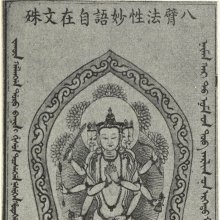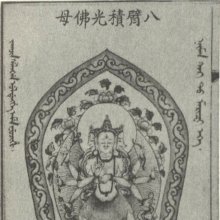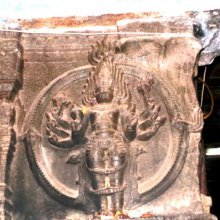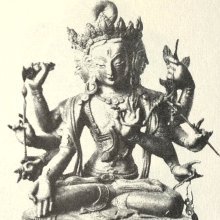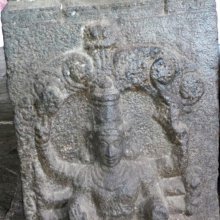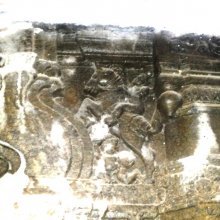Ashtabhuja, Aṣṭabhuja, Aṣṭabhujā, Ashta-bhuja: 7 definitions
Introduction:
Ashtabhuja means something in Buddhism, Pali, Hinduism, Sanskrit. If you want to know the exact meaning, history, etymology or English translation of this term then check out the descriptions on this page. Add your comment or reference to a book if you want to contribute to this summary article.
The Sanskrit terms Aṣṭabhuja and Aṣṭabhujā can be transliterated into English as Astabhuja or Ashtabhuja, using the IAST transliteration scheme (?).
Images (photo gallery)
(+22 more images available)
In Hinduism
Pancaratra (worship of Nārāyaṇa)
Source: SriMatham: Vaiṣṇava Iconology based on Pañcarātra ĀgamaAṣṭa-bhuja (‘Eight arms’): Some icons of the Lord or His manifestations are depicted as having 8 arms. This also represents the complete dominion over all the directions, as well as the eight preserving powers (shakti) of the Lord which are;
- health (ārogya),
- knowledge (jñāna),
- wealth (dhana),
- organization (sampādanam),
- cooperation (sahodyoga),
- fame (kīrti),
- courage (dhrti),
- truth (satyam).
They also symbolize the 8 attributes of the Supreme Being which are;
- sarva-jñatva—omniscience of universe, living entities and deeds. (loka, jiva & karma)
- sarveśvaratva—Supreme Lordship and Dominion over the entire creation.
- sarva-antaryāmitva—inner rulership and control of all entities.
- sarva-karaṇatva—Supreme Cause of all causes.
- sarva-niyantṛitva—Supreme controller of everything.
- sarva-kartṛitva—the original Performer of all actions.
- sarva-śaktimatva—omnipotence
- sva-tantratva—complete and absolute independence.

Pancaratra (पाञ्चरात्र, pāñcarātra) represents a tradition of Hinduism where Narayana is revered and worshipped. Closeley related to Vaishnavism, the Pancaratra literature includes various Agamas and tantras incorporating many Vaishnava philosophies.
Shilpashastra (iconography)
Source: Archaeological Survey of India: Śaiva monuments at Paṭṭadakal (śilpa)Aṣṭabhuja (अष्टभुज) is found as a sculpture at the temple of Lokeśvara, western half of the north wall, northern façade.—Viṣṇu with eight hands, a rare depiction, is carved here with, atop, a scene of Śaṃkara Pārvatī where the god is carrying a Liṅga on his right shoulder.
While enumerating the attributes that are in the hands of the deity, T. A. G. Rao writes: “In the right hands, the gadā, the khaḍga, the bāṇa and the cakra; and in the left hands, the śaṅkha, the kheṭaka, the dhanus and the padma” (Elements … vol. I, pt. i. p. 256). He states further that this image of Vaikuṇṭhanātha should have four heads. But the sculpture at Paṭṭadakal has only one head and except the padma in one of his hands, the attribution of attributes, as given by T. A. G Rao, fits well.
Viṣṇu is well decorated with a tiara and hāra. Besides, he wears a sacred thread (yajñopavīta) which descends down to the right mid-hip and another hāra which goes below the knees. Probably, it is vaijayantī hāra. Śaṅkhanidhi and Padmanidhi are shown seated on either side of his feet. Both are figured plump with a bulging stomach, wearing kirīṭa. On the pilasters of the niche are depicted two seated images, which are difficult to identify.

Shilpashastra (शिल्पशास्त्र, śilpaśāstra) represents the ancient Indian science (shastra) of creative arts (shilpa) such as sculpture, iconography and painting. Closely related to Vastushastra (architecture), they often share the same literature.
Shaktism (Shakta philosophy)
Source: Google Books: ManthanabhairavatantramAṣṭabhujā (अष्टभुजा) refers to “she who has eight arms”, according to the Manthānabhairavatantra, a vast sprawling work that belongs to a corpus of Tantric texts concerned with the worship of the goddess Kubjikā.—Accordingly, “The auspicious Uḍumaṅgalyā in the west has six faces and eight arms [i.e., aṣṭabhujā] and is auspicious. She is beautiful, her hair is dishevelled and she is adorned with all the ornaments. She holds an ascetic’s staff, a javelin, a cup (pātra) and double-headed drum in her right hands, (and) a skull, a bow and sword along with a severed head in the left. She sits on a ghost and, when worshipped, she destroys the enemy”.

Shakta (शाक्त, śākta) or Shaktism (śāktism) represents a tradition of Hinduism where the Goddess (Devi) is revered and worshipped. Shakta literature includes a range of scriptures, including various Agamas and Tantras, although its roots may be traced back to the Vedas.
Shaivism (Shaiva philosophy)
Source: SOAS University of London: Protective Rites in the Netra Tantra1) Aṣṭabhuja (अष्टभुज) refers to “eight-armed” and is used to describe Viṣṇu, according to the Netratantra of Kṣemarāja: a Śaiva text from the 9th century in which Śiva (Bhairava) teaches Pārvatī topics such as metaphysics, cosmology, and soteriology.—Accordingly, [verse 13.1-9, while describing the appearance and worship of Viṣṇu]—“Or, [the Mantrin] worships a very handsome, eight-armed (aṣṭabhuja), yellow Deva. He is naked, sits on a ram, and is unadorned He rests on one horn [of a sheep and] offer up a pile of wheel spokes, the hand... having the shape of a boy. [He is] constantly at play with a flock of beautiful, naked women. [...]”.
2) Aṣṭabhuja (अष्टभुज) or “eight-armed” is also used to describe Sūrya.—Accordingly, [verse 13.17-25ab, while describing the appearance and worship of Sūrya]—“Now, I explain that which consists of light [i.e., Sūrya]. [...] Or [the Mantrin should visualize him with] eight arms (aṣṭabhuja), bearing the weapons of the Lokapālas. [Here Sūrya is endowed with] three terrible faces, [each with] three eyes, [and he is] disfigured. One should worship him [visualized as] mounted on a horse in the middle of a lotus. [The worshipper] honors [his] heart, head, and topknot, enveloped with the weapon of sight. [...]”.

Shaiva (शैव, śaiva) or Shaivism (śaivism) represents a tradition of Hinduism worshiping Shiva as the supreme being. Closely related to Shaktism, Shaiva literature includes a range of scriptures, including Tantras, while the root of this tradition may be traced back to the ancient Vedas.
In Buddhism
Tibetan Buddhism (Vajrayana or tantric Buddhism)
Source: Brill: Śaivism and the Tantric Traditions (tantric Buddhism)Aṣṭabhuja (अष्टभुज) refers to “(having) eight arms”, according to the Nāmamantrārthāvalokinī by Vilāsavajra, which is a commentary on the Nāmasaṃgīti.—Accordingly, [while describing Ādibuddha]—“[...] He is tranquil, with the ornaments of a youth, in fine clothing, wearing about himself a many coloured garment. He has eight arms (aṣṭabhuja), holding at his heart with four hands the Śatasāhasrikāprajñāpāramitā divided into four parts, [and] carrying, in each of the other four hands, a sword of wisdom in the gesture of striking. [All this is to be] put in place [i.e. visualised] via the yoga of the four Buddha-thrones”.

Tibetan Buddhism includes schools such as Nyingma, Kadampa, Kagyu and Gelug. Their primary canon of literature is divided in two broad categories: The Kangyur, which consists of Buddha’s words, and the Tengyur, which includes commentaries from various sources. Esotericism and tantra techniques (vajrayāna) are collected indepently.
Languages of India and abroad
Sanskrit dictionary
Source: Cologne Digital Sanskrit Dictionaries: Monier-Williams Sanskrit-English DictionaryAṣṭābhujā (अष्टाभुजा):—[=aṣṭā-bhujā] [from aṣṭā > aṣṭan] f. ‘having eighteen arms’, a Name of Durgā, [cf. Lexicographers, esp. such as amarasiṃha, halāyudha, hemacandra, etc.]
Sanskrit, also spelled संस्कृतम् (saṃskṛtam), is an ancient language of India commonly seen as the grandmother of the Indo-European language family (even English!). Closely allied with Prakrit and Pali, Sanskrit is more exhaustive in both grammar and terms and has the most extensive collection of literature in the world, greatly surpassing its sister-languages Greek and Latin.
Kannada-English dictionary
Source: Alar: Kannada-English corpusAṣṭabhuja (ಅಷ್ಟಭುಜ):—
1) [noun] he that has eight arms.
2) [noun] a plain figures with eight sides; an octagon.
Kannada is a Dravidian language (as opposed to the Indo-European language family) mainly spoken in the southwestern region of India.
See also (Relevant definitions)
Partial matches: Ashta, Bhuja.
Starts with: Ashtabhujahasta, Ashtabhujakurukulla, Ashtabhujamarici, Ashtabhujapita, Ashtabhujashtaka.
Full-text: Ashtbhuj, Maheshvara, Varali, Krodheshvari, Vadali, Varahamukhi, Varttali, Caturvaktra-Surya, Vishuddhaheruka, Krodhishvari, Varaha, Kurukulla, Maricipicuva, Cunda.
Relevant text
Search found 5 books and stories containing Ashtabhuja, Aṣṭā-bhujā, Aṣṭabhuja, Astabhuja, Asta-bhuja, Aṣṭābhujā, Aṣṭabhujā, Ashta-bhuja, Aṣtabhuja, Aṣṭa-bhujā; (plurals include: Ashtabhujas, bhujās, Aṣṭabhujas, Astabhujas, bhujas, Aṣṭābhujās, Aṣṭabhujās, Aṣtabhujas). You can also click to the full overview containing English textual excerpts. Below are direct links for the most relevant articles:
The Indian Buddhist Iconography (by Benoytosh Bhattachacharyya)
Figure 192 - Emanations of Ratnasambhava: Prasannatārā (Prasanna Tārā)
Figure 161-164 - Emanations of Vairocana: Cundā
Figure 152-155 - Emanations of Vairocana: Aṣṭabhuja and Daśabhujasita Mārīcī
Brihad Bhagavatamrita (commentary) (by Śrī Śrīmad Bhaktivedānta Nārāyana Gosvāmī Mahārāja)
Verse 2.4.38 < [Chapter 4 - Vaikuṇṭha (the spiritual world)]
Lord Hayagriva in Sanskrit Literature (by Anindita Adhikari)
Hayagrīva in Buddhism < [Chapter 6]
Maha Prajnaparamita Sastra (by Gelongma Karma Migme Chödrön)
Part 11 - Why is the Buddha called Buddha < [Chapter IV - Explanation of the Word Bhagavat]
The Devi Bhagavata Purana (by Swami Vijñanananda)
Related products
